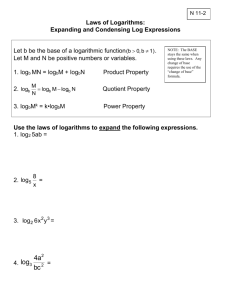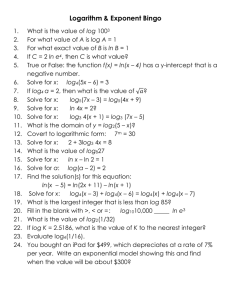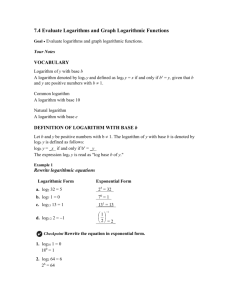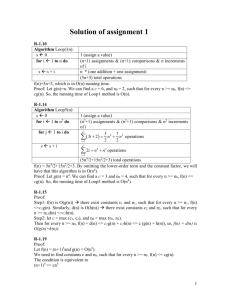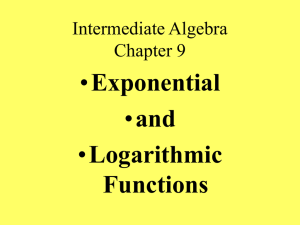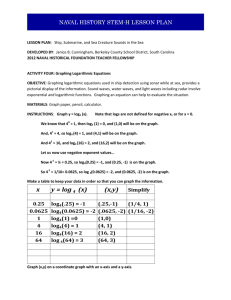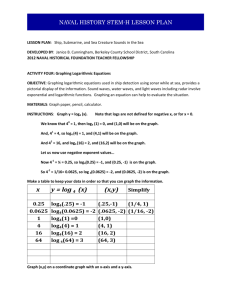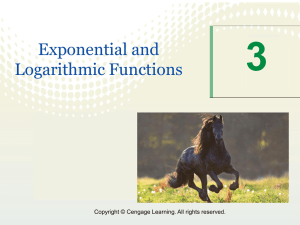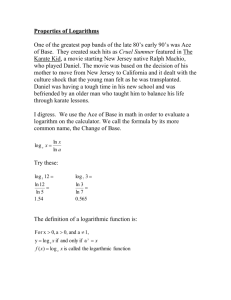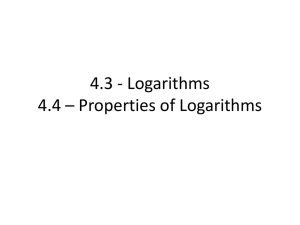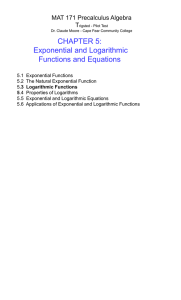Section 12.3 - MiraCosta College
advertisement
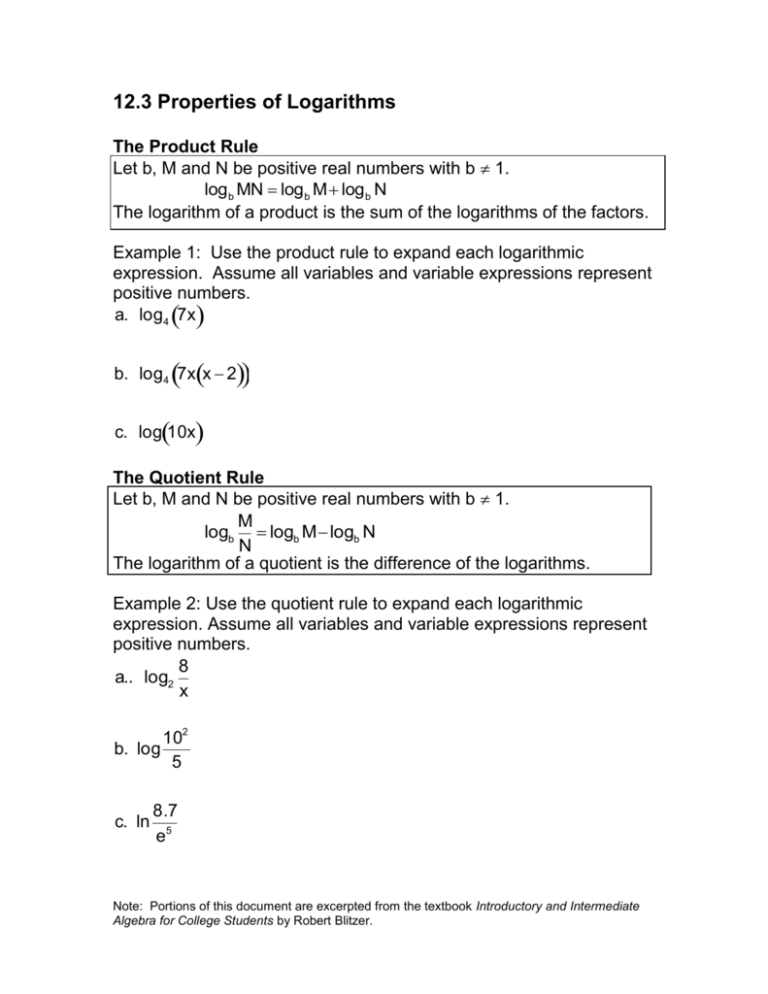
12.3 Properties of Logarithms
The Product Rule
Let b, M and N be positive real numbers with b 1.
log b MN log b M log b N
The logarithm of a product is the sum of the logarithms of the factors.
Example 1: Use the product rule to expand each logarithmic
expression.
Assume all variables and variable expressions represent
positive numbers.
a. log4 7x
b. log4 7xx 2
c. log10x
The Quotient Rule
Let b, M and N be positive real numbers with b 1.
M
logb logb M logb N
N
The logarithm of a quotient is the difference of the logarithms.
Example 2: Use the quotient rule to expand each logarithmic
expression.
Assume all variables and variable expressions represent
positive numbers.
8
a.. log2
x
102
b. log
5
c. ln
8.7
e5
Note: Portions of this document are excerpted from the textbook Introductory and Intermediate
Algebra for College Students by Robert Blitzer.
The Power Rule
Let b and M be positive real numbers with b 1, and let p be any real
number.
logb Mp plogb M
The logarithm of a number with an exponent is the product of the
exponent and the logarithm of that number.
Example
3: Use the power rule to expand each logarithmic
expression. Assume all variables and variable expressions represent
positive numbers.
a. log3 x 6
b. log2 7x
4
c. log6 x
Expanding Logarithmic Expressions
Summary of Properties for Expanding Logarithmic Expressions
1. log b MN log b M log b N
Product Rule
M
2. logb logb M logb N
Quotient Rule
N
3. logb Mp plogb M
Power Rule
Expanding logarithmic expressions may require that you use more
than one property.
Example 4: Use logarithmic properties to expand each expression as
much as possible. Assume all variables and variable expressions
represent positive numbers.
a. log2 2x 2
Note: Portions of this document are excerpted from the textbook Introductory and Intermediate
Algebra for College Students by Robert Blitzer.
b. log
101.5
x
c. logb x 4 3 y
d. log 4
x
25y 3
Condensing Logarithmic Expressions
To condense a logarithmic expression, we write a sum or difference
of two logarithmic expressions as a single logarithmic expression.
Use the properties of logarithms to do so.
Restatement of Properties of Logarithms:
1. log b M log b N log b MN
Product Rule
M
2. logb M logb N logb
Quotient Rule
N
3. plogb M logb Mp
Power Rule
Example 5: Write as a single logarithm. Assume all variables and
variable expressions represent positive numbers.
a. log25 log4
b. log2x log4
c. logx 1 logx 4
Note: Portions of this document are excerpted from the textbook Introductory and Intermediate
Algebra for College Students by Robert Blitzer.
d. 2logx log4
e. 7log4 5x log4 8
f.
1
log2 x 2log2 5y 2
2
The Change-of-Base Property
For any logarithmic bases a and b, and any positive number M,
loga M
logb M
loga b
The logarithm of M with base b is equal to the logarithm of M with any
new base divided by the logarithm of b with that new base.
Since calculators generally have keys for only common or natural
logs, thechange of base formula must be used to evaluate logarithms
with bases other than 10 or e.
If the new base, a, is chosen to be 10 or e, the change-of-base
formula becomes:
logM
lnM
or
logb M
logb M
logb
lnb
Example 6: Evaluate each logarithm. Round your answer to the
nearest hundredth.
a. log 133
2
b. log0.5 23.5
c. log6 458
Note: Portions of this document are excerpted from the textbook Introductory and Intermediate
Algebra for College Students by Robert Blitzer.
Example 7: Use the change-of-base formula and your graphing
calculator to graph fx log2 x 1. Indicate any vertical asymptotes
with a dotted line.
Example 8: Use your graphing calculator to graph fx 2logx and
f x logx2 . Show the graphs on the grid below Explain why the
graphs are different.
Note: Portions of this document are excerpted from the textbook Introductory and Intermediate
Algebra for College Students by Robert Blitzer.
Answers Section 12.3
Example 1:
a. log 4 7 log4 x
b. log4 7 log4 x log4 x 2
c. 1 logx
Example 2:
a. 3 log2 x
b. 2 log5
c. ln8.7 5
Example 3:
a. 6log3 x
b. 4log2 7x
c.
1
log6 x
2
Example 4:
a. 1+ 2log2 x
1
b. 1.5 logx
2
1
c. 4logb x logb y
3
1
d. log4 x log4 25 3log4 y
2
Note: Portions of this document are excerpted from the textbook Introductory and Intermediate
Algebra for College Students by Robert Blitzer.
Example 5:
a. 2
b. log8x
c. log x 1x 4
x 2
d. log
4
7
5x
e. log4
8
f. log2 25y 4 x
Example 6:
a. 7.06
b. 4.55
c. 3.42
Example 7:
Note: Portions of this document are excerpted from the textbook Introductory and Intermediate
Algebra for College Students by Robert Blitzer.
Example 8:
The domain of f(x) log2 x2 is the set of all real numbers except 0
but the domain of f(x) 2log 2 x is the {x/ x>0}.
f(x) log2 x2
f(x) 2log 2 x
Note: Portions of this document are excerpted from the textbook Introductory and Intermediate
Algebra for College Students by Robert Blitzer.
